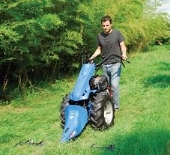Hi Burton,
Here is an excerpt from this article, you may find it helpful.
Mother Earth Cover Crops and Fungi
How to Use Cover Crops and Other Techniques to Increase Beneficial Fungi Populations
An equally important step is to ensure that mycorrhizal fungi survive through winter and early spring. The kinds of mycorrhizal fungi that support many garden crops aren’t capable of living and reproducing independently of their plant partners. In a carefully weeded and fully harvested garden, mycorrhizal fungi numbers can decline for lack of live roots to colonize. Douds advises avoiding empty beds by keeping plants, whether food crops or cover crops growing at all times. (See The Best Summer Cover Crops for ideas.) In fall, plant rye, oats or, Douds’ favorite, hairy vetch. All of these plants have extensive root systems and readily harbor mycorrhizae. Rows of perennial onions and strawberries can also serve as reservoirs for overwintering fungi. Orchards don’t require the same attention, but buffer strips of a grass-and-legume blend will help retain a mix of fungi.
Douds sows hairy vetch in September while his garden is still producing, targeting areas where the soil is accessible, such as under and around tomato plants. The following year — usually late May when the hairy vetch is in full flower — he chops the shoots and lets them lie on the soil’s surface. Wait until the hairy vetch is in full flower; cut it too soon and it will re-sprout as a “weed,” but cut it too late and it will produce seeds, which can be problematic. Douds then transplants his tomatoes, peppers and other vegetables into the hairy vetch mulch.
Since learning about mycorrhizae’s reliance on live plants for winter survival, Mother’s Editor-in-Chief, Cheryl Long, has grown a thin strip of perennial alfalfa along the edges of her garden paths. “It doesn’t take up growing space, and during summer I cut it for protein-rich poultry feed,” Long says.
Many gardeners know that over-fertilization can be harmful, but they may not be aware that phosphorus builds up in soil more readily than the other two elements in common fertilizer mixes (nitrogen and potassium). Under a regimen of frequent, well-intended application, phosphorus can reach levels that actually discourage the formation of mycorrhizae. Phosphorus is the middle number of the N-P-K percentages shown on fertilizer products. Choose low “P” numbers unless a soil test has shown your soil is low in phosphorus.







